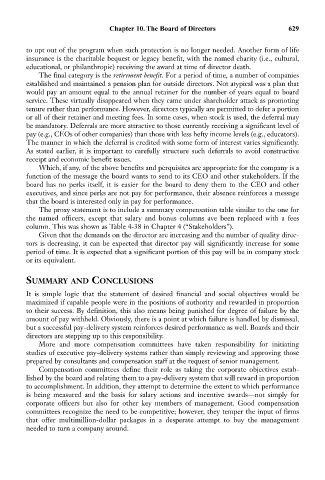Page 644 - Bruce Ellig - The Complete Guide to Executive Compensation (2007)
P. 644
Chapter 10. The Board of Directors 629
to opt out of the program when such protection is no longer needed. Another form of life
insurance is the charitable bequest or legacy benefit, with the named charity (i.e., cultural,
educational, or philanthropic) receiving the award at time of director death.
The final category is the retirement benefit. For a period of time, a number of companies
established and maintained a pension plan for outside directors. Not atypical was a plan that
would pay an amount equal to the annual retainer for the number of years equal to board
service. These virtually disappeared when they came under shareholder attack as promoting
tenure rather than performance. However, directors typically are permitted to defer a portion
or all of their retainer and meeting fees. In some cases, when stock is used, the deferral may
be mandatory. Deferrals are more attractive to those currently receiving a significant level of
pay (e.g., CEOs of other companies) than those with less hefty income levels (e.g., educators).
The manner in which the deferral is credited with some form of interest varies significantly.
As stated earlier, it is important to carefully structure such deferrals to avoid constructive
receipt and economic benefit issues.
Which, if any, of the above benefits and perquisites are appropriate for the company is a
function of the message the board wants to send to its CEO and other stakeholders. If the
board has no perks itself, it is easier for the board to deny them to the CEO and other
executives, and since perks are not pay for performance, their absence reinforces a message
that the board is interested only in pay for performance.
The proxy statement is to include a summary compensation table similar to the one for
the named officers, except that salary and bonus columns ave been replaced with a fees
column. This was shown as Table 4-38 in Chapter 4 (“Stakeholders”).
Given that the demands on the director are increasing and the number of quality direc-
tors is decreasing, it can be expected that director pay will significantly increase for some
period of time. It is expected that a significant portion of this pay will be in company stock
or its equivalent.
SUMMARY AND CONCLUSIONS
It is simple logic that the statement of desired financial and social objectives would be
maximized if capable people were in the positions of authority and rewarded in proportion
to their success. By definition, this also means being punished for degree of failure by the
amount of pay withheld. Obviously, there is a point at which failure is handled by dismissal,
but a successful pay-delivery system reinforces desired performance as well. Boards and their
directors are stepping up to this responsibility.
More and more compensation committees have taken responsibility for initiating
studies of executive pay-delivery systems rather than simply reviewing and approving those
prepared by consultants and compensation staff at the request of senior management.
Compensation committees define their role as taking the corporate objectives estab-
lished by the board and relating them to a pay-delivery system that will reward in proportion
to accomplishment. In addition, they attempt to determine the extent to which performance
is being measured and the basis for salary actions and incentive awards—not simply for
corporate officers but also for other key members of management. Good compensation
committees recognize the need to be competitive; however, they temper the input of firms
that offer multimillion-dollar packages in a desperate attempt to buy the management
needed to turn a company around.

